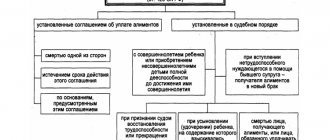Consequences of having debt to pay for housing and communal services
When debts arise for utility services, various consequences can occur. Among them are:
- accrual of penalties;
- seizure of property;
- restrictions on the disposal of real estate;
- introduction of a ban on travel outside the country;
- forced eviction of the debtor.
Pernicious violators face legal action.
Find out in more detail what the consequences of debt on utility bills are.
Can utility workers turn off the sewer system?
Many citizens are interested in whether sewerage can be blocked for debts. The thing is that in the current version the direct ban on turning off the sewer system has been abolished. In this regard, management companies (MCs) that collect payments are now threatening defaulters with suspension of the resource supply.
It states that the only way to influence malicious debtors and non-payers of housing and communal services is to limit or suspend water drainage and water supply.
At the same time, in search of an answer to the question of whether housing and communal services can turn off sewerage, it is worth considering that the above-mentioned resolution contains an important condition, according to which the suspension of any type of utility services should not:
- damage the common property of residents of an apartment building;
- violate the rights of other owners, including the suitability of residential premises.
Therefore, if a consumer doubts whether the sewerage system in the house was legally turned off, you can go to court to stop interfering with the sanitary and technical condition of the apartment building equipment.
Legislation on restriction of water disposal
Any service provided in the housing and communal services sector is subject to mandatory payment. If the user does not pay for the consumed resources for more than 2 months , on the basis of Article 21 of Federal Law No. 416, his access to services will be partially or completely limited. The procedure for blocking the sewer system in the debtor's apartment is a complex and lengthy process.
Restricting water supply consists of several stages:
- resource supplying organizations turn to management companies with claims for non-payment of housing and communal services;
- based on the received application, representatives of the management company address the debtor with a demand for repayment of the debt;
- if funds have not been received into the management company’s account within the established period, a water discharge restriction is imposed on the debtor. To do this, a plug is installed. The debt to the utility service provider is repaid at the expense of the management company’s own funds.
Temporary suspension of sewerage services is recognized as legal if the subscriber does not pay bills for more than 2 months. If the debtor does not agree with the decision, he has the right to appeal it in court.
Notice of drainage restrictions
If a defaulter ignores demands for debt repayment, a blocking device is installed in his home, limiting access to water resources.
Before proceeding with the implementation of this measure, the management company is obliged to send written notifications about the upcoming procedure in 4 copies to the debtor, local authorities, and the territorial unit for sanitary and epidemiological supervision and fire safety. The document indicates the exact amount of the debt and sets out the procedure for temporarily limiting water disposal in case of non-payment.
The notice indicates a specific date when utilities plan to restrict water disposal to debtors. A mandatory requirement is that the subscriber be present at home . If he interferes with the work crew, locks himself in the apartment and does not open the door, the management company has the right to go to court. In some constituent entities of the Russian Federation, there are regional laws that establish an administrative fine for not admitting housing and communal services workers.
Sample notice of water disposal restrictions:
Sewer shutdown procedure
The management company cannot turn off the sewer system for a single failure to pay utility bills. In addition, she must warn the debtor about such an intention.
Restriction of water disposal without a court decision can be made no earlier than twenty days after delivery of a written warning, if the defaulter does not repay the debt before this time.
If the debtor does not take any action to pay the bills, the management company has the right to limit or suspend drainage.
In accordance with clause 119 of the “Rules for the provision of utility services...”, approved by Decree of the Government of the Russian Federation dated 05/06/11 No. 354, the contractor, in the event of absence or incomplete payment by the consumer for a utility service, has the right, after a written warning (notification), to limit or suspend its provision in the following order:
- send a warning (notification) to the consumer-debtor that in case of failure to repay the debt for payment of utility services within 20 days, the provision of such services may be first limited and then suspended (if there is no technical possibility, the restrictions may be suspended without it). The warning (notification) must be delivered to the debtor against signature or sent by registered mail (with acknowledgment of receipt) or included in the payment document for utilities the text of the corresponding warning (notification) or in another way;
- If the consumer fails to repay the debt within the period established in the notification, the contractor introduces a restriction on the provision of utility services (if technically possible);
- If the debt is not repaid after 10 days from the date of introduction of the restriction, the contractor may suspend the provision of utility services, with the exception of heating, and in apartment buildings, also with the exception of cold water supply. If it is not technically possible to introduce a restriction, then suspension is possible immediately after the expiration of the period specified in the notification.
Since the legislation does not separately stipulate at what amount of debt the sewer plugs are installed, this allows the management company to determine the monetary value independently.
General information
Types of locking systems
There are different types of blocking. The plugs of different systems have distinctive characteristics.
Common devices include the Whale and the Octopus.
The SPRUT plug includes a video camera, a long probe, a blocking plug, and a manipulator.
Positive characteristics of the plug:
- -has a video camera.
- - blocks the sewer riser completely or in parts.
The device is pushed into the sewer pipe through the ventilation, where it blocks the drainage hole completely or partially.
The pipe will not change its geometry, and neighbors in the house will not experience restrictions on the use of the sewerage system.
The plugs are made of steel, which resists aggressive environments and is also not subject to mechanical stress.
The KIT lock has a probe with a control panel and a camera.
Positive characteristics:
-has LED lamps, with the help of which they find the desired apartment.
-has a control panel, you can control the operation of the system from a distance.
The blocking probe passes through the central riser to a specific outlet location where the plug is installed.
Less popular plug systems include:
1.Glot, equipped with a cable with a manipulator at the end and a small video camera.
2.Terminator Pro.
3. The Sov has a plug in the form of a polymer sleeve, which is pressed into the section of the pipeline where there is a debt and closed with a lock.
To remove the blocking, you must pay the debt for the apartment in full.
Stub - a form of dealing with debtors
There are two types of locking systems:
-absolute view covers the waste drain in full.
-the lattice type partially blocks the passage of sewage, allowing passage only for liquid forms of waste.
If the debt is two months old, then housing services have the right to install a plug.
The management organization does not have the right to enter an apartment with debts; it is forced to block the sewer system so as not to cause inconvenience to the neighbors.
Features of installing the plug:
1.specialists study the pipeline diagram and select a location for the plug.
2. determined using one or type of plug.
3.set the lock using a manipulator with a video surveillance camera.
The operator monitors the installation process from start to finish.
Before installation, the defaulter receives a notification that restrictive measures are being applied to him regarding the provision of sewerage services.
If the sewer is closed without warning, the debtor can sue the management company for illegality of action.
Based on judicial practice, it can be argued that this type of case ends in favor of the plaintiff.
Sewer blocking procedure
Perhaps someone is interested in learning more about how sewers are blocked for debts. First of all, the specialist determines where the central drainage riser is located in the house. He inserts a plug into it and advances it to the problem apartment. After this, a special outlet is installed, with the help of which the problem area is cut off.
At the same time, the central riser remains open. This makes it possible to install a block that does not interfere with drainage from other rooms in the house, but isolates only the apartment whose residents have accumulated debts.
Many debtors would like to find out whether they have the right to put a cap on the sewer when they owe a debt on utility bills. If we look at the legal norms, it becomes clear that such a procedure is completely legal.
In this situation, an agreement is drawn up to limit water drainage by installing a plug. The management company may not even resort to legal proceedings, since this is not necessary. She has the right to put a cap on the sewer without a court decision.
Is it possible to remove the lock yourself?
It is almost impossible for the debtor to remove the block on his own. The fact is that:
- this requires special equipment, which only management companies have (however, other companies, as well as private craftsmen, also have it, but we will talk about this later);
- This requires dismantling the toilet, which is quite problematic.
Therefore, the best way out of the situation is to pay for utilities and not solve the problem yourself.
But if for one reason or another you cannot pay off the debt and apply to the Criminal Code for unblocking, then you have only one option left - disconnecting the toilet from the common riser and partially dismantling the common riser.
To do this we need to prepare the following tools:
- durable hook;
- adjustable wrench;
- several wrenches;
- pliers;
- dowels;
- hammer;
- flashlight.
Remember that when you remove the blockage with your own hands, there is a high probability of malfunction of the common riser. Therefore, weigh all the pros and cons, and if the former still outweigh, then proceed.
The process of removing a blockage from a sewer
As noted earlier, in order to remove the plug it is necessary to dismantle the toilet. It will not be possible to skip over this stage, since the blocker is located just after it.
The process of unblocking a sewer includes:
- Shutting off the water.
- Dismantling the drain tank and all communications.
- Unscrewing bolts from the toilet.
- Dismantling the bell. At its base there is a blockage.
- Removal using a rigid hook. The locking device must be hooked and pulled towards you.
In some cases, you can hook the sewer shutoff device using pliers. If the plug is rubber, then a hard hook or pliers will not be needed. Thanks to the elastic walls, you can simply retract it, and you can, as before, fully use the toilet, sink and bathtub.
If the plug is metal and cannot be removed, then carry out an inspection procedure. Tap the pipes. This will show you where the blockage is located. Drill a hole and insert a pin into it. And, hitting it with a hammer, gradually push the device through.
Installation and removal of sewer plugs. Onyx. How it works
But we categorically do not recommend using these methods, since it will still be revealed and in addition to paying off the debt for housing and communal services, at a minimum you will have to compensate the management company for the cost of damaged equipment and the cost of blocking work, and if as a result of unblocking work the riser gets damaged, then you may have to pay a fine for arbitrariness.
Firms and private sewer removal specialists
Removing the blockage from the sewer system without notifying the management company is currently legal, but it is not known what will happen in the future. Therefore, there are companies and private masters who remove the blockage. They have the same equipment as the management company.
Therefore, if you do not want to pay for utilities and are afraid to solve the problem yourself, then seek help from one of these companies or a private master.
What to do if the drainage system is blocked
Any management company is ready to accommodate a citizen before suspending water supply if he intends to pay off the debt. For example, the parties may agree to pay the accumulated amount in stages by concluding a restructuring agreement.
If for some reason it was not possible to reach an agreement and the service has already been suspended, you need to know what to do if the sewer system is blocked for debt.
You should not remove the plug yourself using technical tools, as this can lead to flooding of your neighbors.
In addition, such actions can be qualified as an administrative offense, and sometimes even fall under the law.
The only correct course of action in this case would be to pay off the debt.
Find out in more detail how debt restructuring for housing and communal services occurs.






